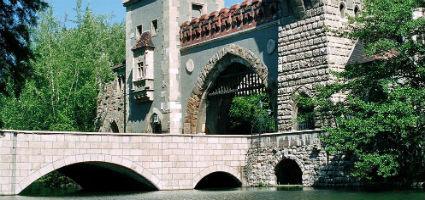2024. April 23. Tuesday
Museum and Library of Hungarian Agriculture - Budapest
 |
Address: 1146, Budapest Városliget, Vajdahunyadvár
Phone number: (1) 363-1117
E-mail: info@mmgm.hu
Opening hours: 01.03-31.10.: Tue-Sun 10-17
01.11-28.02.: Tue-Fri 10-16, Sat-Sun 10-17 |
The exhibition has closed for visitors.
2003.02.07. - 2003.03.01.
Museum tickets, service costs:
|
Individual ticket
|
300 HUF
|
|
|
Individual ticket
|
600 HUF
|
|
|
Ticket for adults
|
1600 HUF
|
|
|
Group ticket for adults
|
500 HUF
|
|
|
Ticket for students
|
800 HUF
|
|
|
Ticket for pensioners
|
800 HUF
|
|
|
Individual combined ticket for adults
|
2100 HUF
|
|
|
Individual combined ticket for students
|
1300 HUF
|
|
|
Individual combined ticket for pensioners
|
1300 HUF
|
|
|
Guide for adults
|
5000 HUF
|
/ capita
|
|
Group guide for students
|
3000 HUF
|
|
|
Group guide
|
8000 HUF
|
With our exhibition we aspire to show the special bridal bouquets of the 20th century. The forms of the bouquets, the bunch of flowers differ at every period of life since they mirror the fashion of the given period. We can also make a difference between the flower arrangement of the capitol and the county.
From the middle of the 19th century the brides, especially the brides of the court of Wien, had little small bouquets we now know as biedermeier bouquet. At the end of the 19th century and at the beginning of the 20th century the so-called water flow type was fashionable. It was laid on the arm of the bride. The rich, mainly civic brides had their bouquets made of live flower. Roses, carnation, kala, lily, and orange flower imported from Italy were used to make bouquets. Long ribbons hung on the sides with little green petals at the end. This type of a bouquet went well with the long white wedding dress that became fashionable at that time. The poor who could not afford live flower had their bouquet made of artificial flower.
In the 1960-70's the live flower bouquet besides the artificial ones came back to fashion. The white carnation, white sword lily was popular. Later the red carnation, red rose, orchid and gerbera became fashionable. Today we meet an extremely varied range of flower arrangement in their forms and the flowers used.
The exhibition is complemented with photo illustrations and original wedding dress accessories that faithfully mirror the styles of flower arrangement, the changes, and the difference between the flower cult in the villages and towns over time.
From the middle of the 19th century the brides, especially the brides of the court of Wien, had little small bouquets we now know as biedermeier bouquet. At the end of the 19th century and at the beginning of the 20th century the so-called water flow type was fashionable. It was laid on the arm of the bride. The rich, mainly civic brides had their bouquets made of live flower. Roses, carnation, kala, lily, and orange flower imported from Italy were used to make bouquets. Long ribbons hung on the sides with little green petals at the end. This type of a bouquet went well with the long white wedding dress that became fashionable at that time. The poor who could not afford live flower had their bouquet made of artificial flower.
In the 1960-70's the live flower bouquet besides the artificial ones came back to fashion. The white carnation, white sword lily was popular. Later the red carnation, red rose, orchid and gerbera became fashionable. Today we meet an extremely varied range of flower arrangement in their forms and the flowers used.
The exhibition is complemented with photo illustrations and original wedding dress accessories that faithfully mirror the styles of flower arrangement, the changes, and the difference between the flower cult in the villages and towns over time.